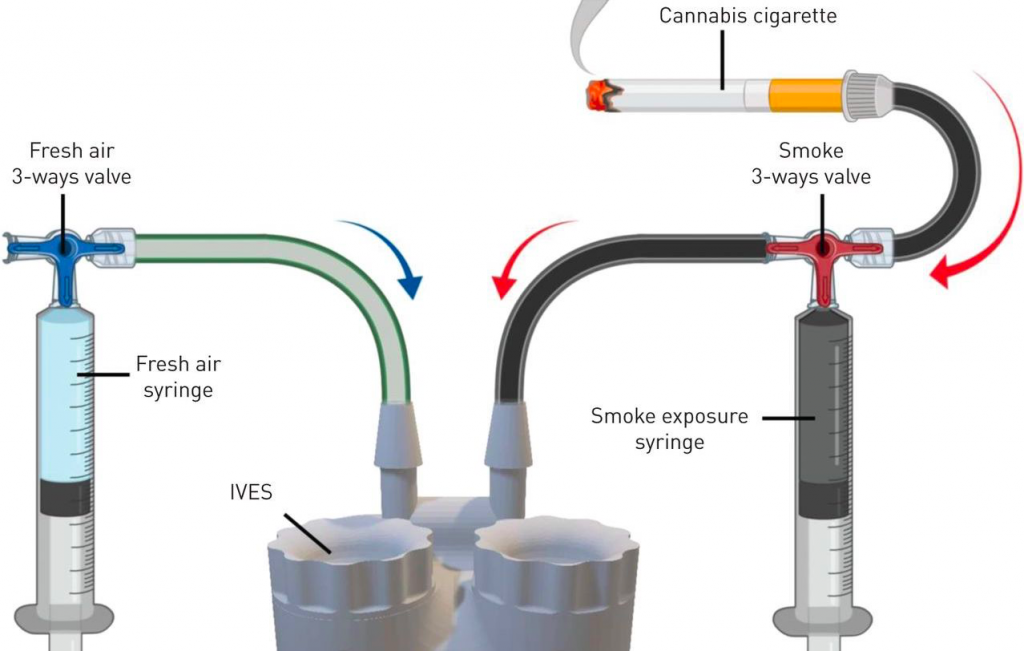Scientists from the Canadian McMaster University and University of Waterloo have 3D printed a live model that’s capable of replicating the impact of smoking cannabis on the human lung.
By loading the ‘In-Vitro Exposure System’ (IVES) with epithelial cells and exposing them to hemp, the team has been able to accurately map the body’s adverse responses to the recreational drug. Following their initial success, the researchers have now made their pot-monitoring device open-source, with the aim of enabling wider research to take place into widening the legalization of marijuana.

Assessing the cost of ‘lighting-up’
While our lungs regularly come into contact with bacteria and viruses, the human body has developed strong immunological responses to prevent us from falling ill. The epithelial cells that line our airways are a vital part of this defense, generating mucus as well as antiviral cytokines, and when damaged by diseases like asthma they become dysfunctional, causing breathing difficulties to affected patients.
According to the Canadian scientists, smoking cannabis constitutes a similar “attack on the lungs,” in that it causes symptoms such as coughing, wheezing and a tight chest. As a result, developing a precise understanding of the impact of smoking pot is pivotal to identifying potential warning signs, in addition to informing government policy, when many are considering legalizing it for medicinal use.
In-vitro testing models are already a vital tool when it comes to tobacco smoke research, but given their cost, inaccuracy and lack of accessibility, they’re rarely used within equivalent cannabis studies. To overcome this, the scientists therefore decided to 3D print a novel IVES system, with the aim of making it as accessible to non-specialist labs as possible.

3D printing a robotic lung
Using a Formlabs Form 2 3D printer, the team fabricated a four-chamber lung-like IVES, featuring two inlets, four outlets and four chamber caps. In theory, the system works by ‘inhaling’ smoke via one of its inlets, before distributing it across its four chambers (which each include a cell-loaded insert), before the fumes exit.
In order to practically test their novel machine, the scientists opted to roll-up some research-grade hashish, light up, and hook the IVES up using a 3-way valve and a syringe. Once the robotic lung had finished ‘smoking’ its joint, the researchers assessed the viability of its epithelial cells, finding that their autoimmune functionality had been badly damaged.
Given that previous studies have drawn links between breathing difficulties and barrier deficiencies, the team considered this evidence that lighting up is bad for the lungs. The researchers also compared their cells’ cytokine levels with those taken from smoking disorder patients, and discovered that recreational pot users are more likely to suffer from throat inflammation, among other respiratory issues.
Although the scientists ultimately conceded that further parameter tests would be needed to verify their results, they consider their apparatus to be a success. In fact, the team believe their approach could be applied in various toxicology studies, ranging from joint and vaping analysis, to assessing the impact of pathogens on the immune system.
Bioprinting and lung transplants
While the Canadian team are taking a preventative approach to lung disease, a considerable amount of progress has also been made into developing 3D bioprinted replacements.
Having investigated the potential of bioprinted organs for the last four years, 3D Systems recently announced a breakthrough in the development of its solid-tissue scaffolds. Working alongside United Therapeutics, the firm has been able to create a system of fabricating vascularized tissues called Print to Perfusion.
In a similar way, United Therapeutics is also working alongside Isreali bioprinting firm CollPlant to turn a tobacco factory into a ‘kidney production line.’ The companies strengthened their partnership last year, signing a new agreement in which they committed to enter the serial manufacturing of kidneys.
On a much smaller scale, a team based at the United States Department of Veterans Affairs (VA) is 3D printing chips that could be capable of supporting failing organs. Ultimately, the researchers aim to fabricate devices that constitute ‘artificial lungs,’ which help to regulate healthy CO2 intake in poorly patients.
The researchers’ findings are detailed in their paper titled “Development and validation of an open-source, disposable, 3D-printed in vitro environmental exposure system for Transwell culture inserts.” The research was co-authored by Abiram Chandiramohan, Mohammedhossein Dabaghi, Jennifer A. Aguiar, Nicholas Tiessen, Mary Stewart, Quynh T. Cao, Jenny P. Nguyen, Nima Makhdami, Gerard Cox, Andrew C. Doxey and Jeremy A. Hirota.
To stay up to date with the latest 3D printing news, don’t forget to subscribe to the 3D Printing Industry newsletter or follow us on Twitter or liking our page on Facebook.
Are you looking for a job in the additive manufacturing industry? Visit 3D Printing Jobs for a selection of roles in the industry.
Featured image shows the Canadian scientists’ 3D printed IVES. Image via the ERJ Open Research journal.



